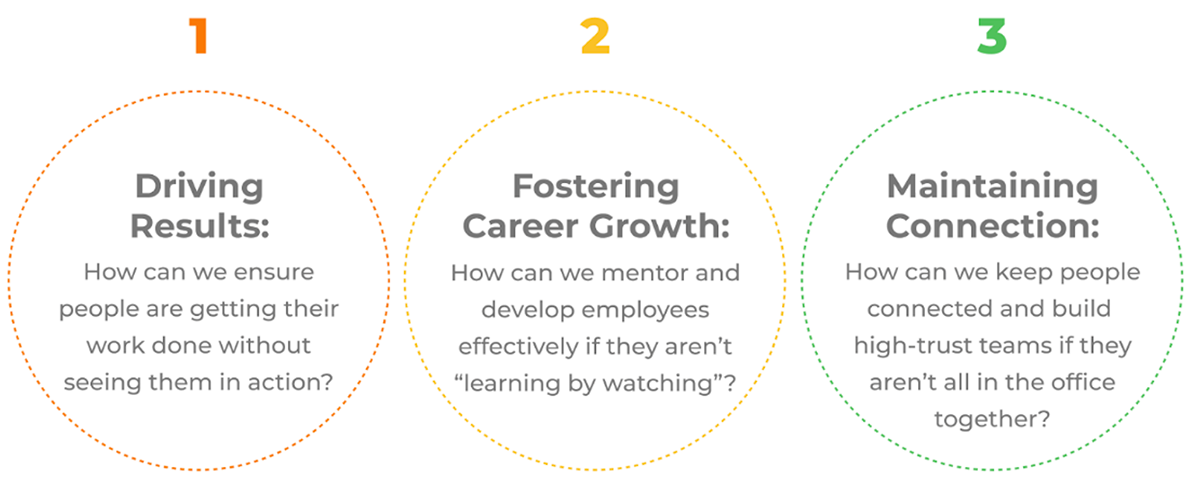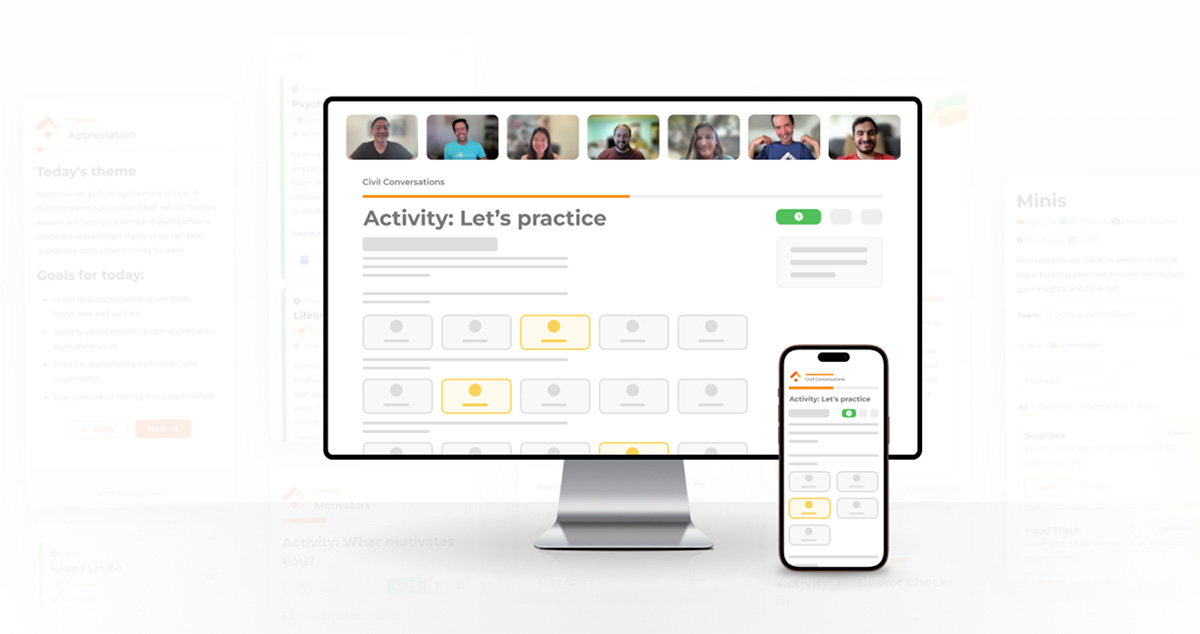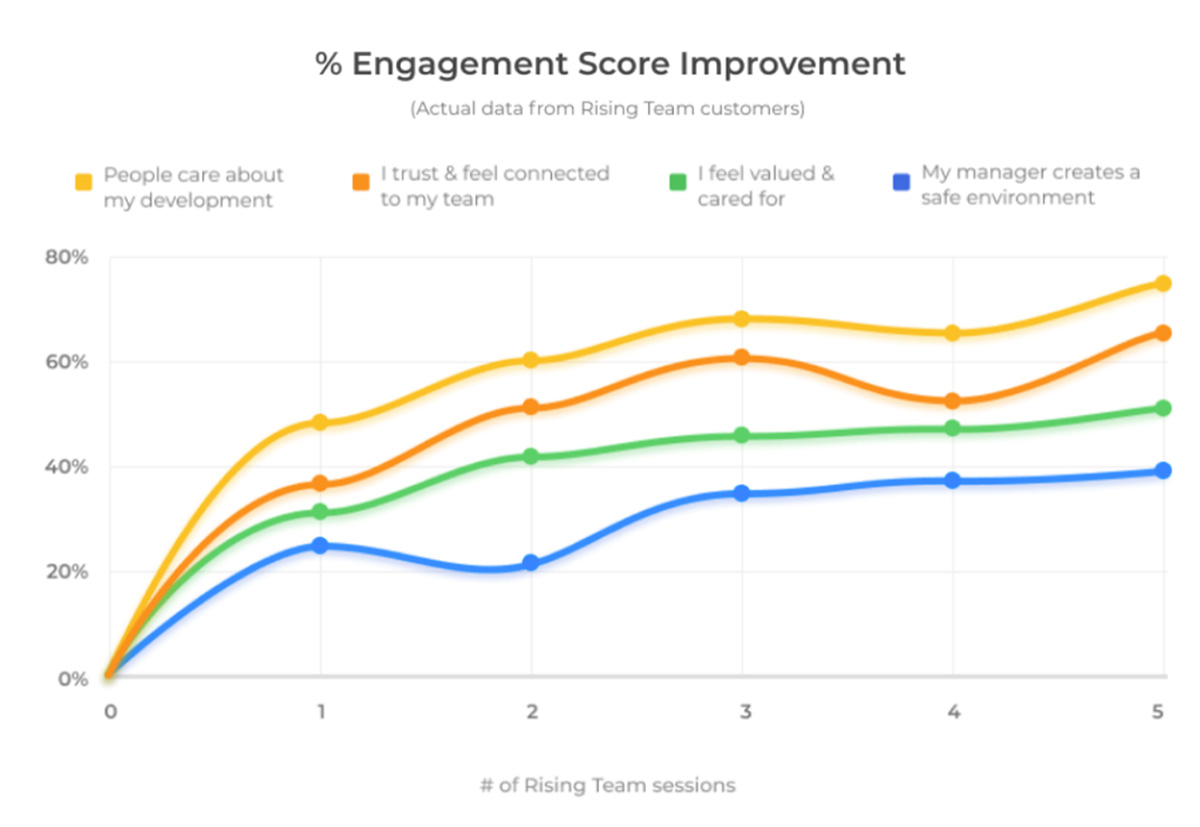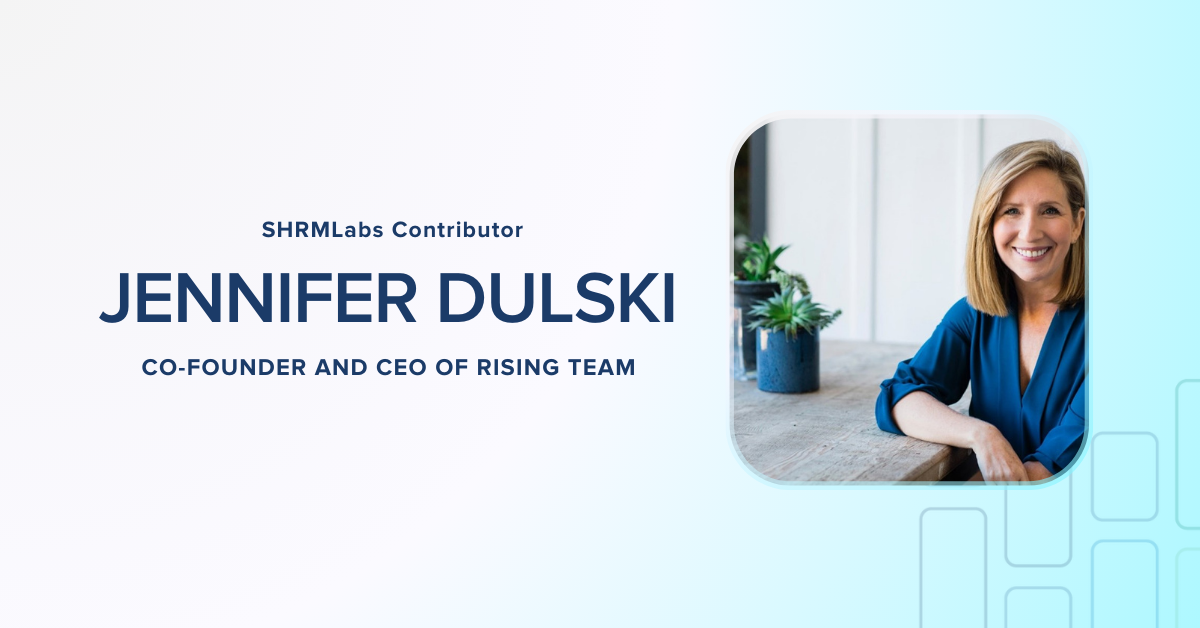Maximizing Hybrid Work Success
Strategies for leaders to build effective, modern teams
Before we begin…
Welcome to the WorkplaceTech Pulse, presented by SHRM Labs. We are expanding our resources to bring you the best possible information from leaders in HR technology and transformation.
My name is Nell Hellem, innovation catalyst at SHRM Labs. You will hear from me as well as my colleagues every other week with the release of each new edition. Let us know any topics you’d like to hear about related to workplace tech and we will consider them for future editions of the WorkplaceTech Pulse.
Introduction
Hybrid work has become the new normal but leading a successful hybrid team comes with its own set of challenges. Balancing business needs with employee preferences, driving results without constant oversight, and maintaining strong team connections are just a few of the hurdles that leaders face.
To effectively navigate this shift, leaders need thoughtful strategies and tools to build high-performing teams in hybrid environments. By focusing on productivity, career development, and maintaining team cohesion, leaders can address these challenges and create a successful hybrid work culture for both employees and the organization.
I’m excited to introduce this edition’s contributor, Jennifer Dulski, co-founder and CEO of Rising Team. Jen, over to you!
Thanks, Nell! I’m Jennifer Dulski, founder & CEO of Rising Team.
With over 25 years of experience leading large teams at Google, Facebook, Yahoo!, and Change.org, I understand first hand the challenges of building high-performing, distributed teams. Although I was fortunate to have access to executive coaches and training, I often felt like I had a guide but lacked the right tools to bring what I had learned back to my own team—like having a book on how to fish but no fishing pole. This inspired me to build Rising Team to equip managers with both the knowledge and the tools to support their teams.
Today, I’m dedicated to helping leaders build high-performing teams. I am also on the faculty at Stanford Graduate School of Business, where I teach a course called "Managing Growing Enterprises," focusing on equipping future leaders with the capabilities to thrive in complex environments.
At Rising Team, we’ve created a platform designed to empower leaders to transform team performance across their organizations. Our platform offers software-guided, interactive skill-building workshops, connection and trust-building exercises, and an AI leadership coach that understands your team’s unique dynamics. We proudly support a diverse range of organizations, from global Fortune 100 companies, to hybrid teams at mid-sized companies like banks and tech startups, as well as in-person teams at nonprofits, K-12 schools, and government agencies.
Be sure to check out all of our editions of the WorkplaceTech Pulse!
The Real Issues in Hybrid Work
As I work with company executives and HR leaders across various industries who are navigating hybrid work, one challenge consistently rises to the top: How do we balance business needs with employee preferences?
The data is clear that employees prefer hybrid or remote work, and in fact, a Stanford University study found many would even consider taking a pay cut or switching jobs to keep those work formats. Yet, leaders need to ensure business outcomes with employee satisfaction. These goals are interconnected, but it falls on leaders to prove that a hybrid structure can be a viable structure to drive business success.
People leaders are juggling a wide range of requests from stakeholders—including retaining talent, ensuring productivity, preserving culture, and supporting financial growth—but at the core, executive concerns about hybrid work often boil down to three key challenges:
- Driving results. How can we ensure people are getting their work done without seeing them in action?
- Fostering career growth. How can we mentor and develop employees effectively if they aren’t “learning by watching”?
- Maintaining connection. How can we keep people connected and build high-trust teams if they aren’t all in the office together?

Addressing these core concerns is crucial for leading a successful hybrid workforce and ensuring alignment with your organization’s strategic goals.
I understand firsthand how challenging it can be to build and sustain high-performing, distributed teams. With over 25 years of experience leading teams at Google, Facebook, Yahoo!, and Change.org, I’ve faced these challenges head-on. Today, I dedicate my time to helping others build high-performing teams, whether through my teaching at the Stanford Graduate School of Business or as the founder and CEO of Rising Team.
In my experience, the right strategy can transform the complexities of hybrid work into opportunities to drive meaningful results, foster growth, and strengthen connections across your organization.
Hybrid Work: A Win-Win for Employees and Companies
Hybrid work has completely transformed the way we think about the workplace. Today, 76% of workers with “teleworkable” jobs—jobs that can be completed at least partially from a location other than the formal worksite—report that they are working from home at least part of the time.
This shift is driven by a demand for better work/life balance and the need to accommodate a diverse workforce. Flexibility is key, especially for parents and caregivers who benefit from structuring their workdays. In fact, hybrid workers value this model highly, even equating it to an 8% salary increase. Studies also found that hybrid workers are equally, if not more, productive than their in-person counterparts.
Hybrid work also:
- Saves time. Reduced commuting time allows employees to focus more on their work life and personal life.
- Increases efficiency. Fewer interruptions and more conducive home environments contribute to better performance.
- Enhances well-being. 78% of employees reported that flexible work options improve their overall health and happiness.
- Reduces burnout. Employees with hybrid work options were 12% less likely to experience burnout, demonstrating the mental health benefits of a more flexible work structure.
- Increases job satisfaction. Hybrid workers rate nearly every aspect of their jobs higher than fully in-person workers.
As hybrid work becomes the standard, the role of HR and company leaders in shaping an intentional strategy is more critical than ever. It’s not just about adapting; it’s about embracing change and leading the way.
Success in a high-performing hybrid workplace hinges on changes in both our mindsets and strategies. We used to be able to rely on “serendipitous” connections—like spontaneous interactions at the watercooler or incidental observations in meetings. However, in a hybrid environment, such occurrences are less frequent or may not happen at all if people aren’t in the office at the same time.
Now, fostering development and building trust requires a more intentional approach.
Intentional Is Better than Serendipitous
Relying on “casual” connections was never an effective strategy, and embracing an intentional approach will significantly strengthen teams’ cohesion. We’ll explore techniques and tools to help you be purposeful about driving results, supporting growth, and building connections, whether your employees work remotely, hybrid, or in person.
Strategy 1: Driving Results in Hybrid Work
One of the biggest challenges in a hybrid work environment is maintaining both accountability and productivity. Without the traditional in-office visibility, it can feel trickier to manage output. But the data tells a different story—hybrid work often leads to better performance than full-time office setups.
Research shows that hybrid workers can be as productive, if not more so, than their in-office peers. A McKinsey study found that companies with well-implemented hybrid models saw productivity jump by up to 55%. This boost comes from the flexibility that hybrid work offers, allowing for better focus, fewer distractions, and improved work/life balance.
For HR leaders, the key is to design a hybrid model that maintains high performance, which may require a shift in how your organization views productivity. It’s not about the hours spent at a desk or even time working; it’s about the results delivered. As NPR reporter Greg Rosalsky aptly put it, focusing on input can create a “theater of productivity”—an illusion of busy-ness rather than real progress.
Here’s how we approach “outcomes over outputs” at Rising Team and how we help our customers achieve the same:
- Measure what matters. Venture capitalist John Doerr, an advocate for OKR (objectives and key results), wrote in his book Measure What Matters (Portfolio Penguin, 2018) that “what you measure, you improve.” Basically, the metrics you focus on shape the results you achieve. So, set clear, role-specific goals that focus on outcomes rather than just time spent or tasks completed. This way, employees can excel and stay motivated with the bigger picture in mind. For instance, a customer support agent may have a goal that is a number of calls completed with a satisfaction score over a certain percentage, whereas a salesperson may have a revenue goal as their primary outcome, rather than focusing purely on the number of calls they make.
- Introduce frameworks for productivity. To set clear expectations upfront, we use frameworks such as ROAD (Results-Obstacles-Alignment-Delivery) to prioritize outcomes, letting employees work in a way that suits them best. We help teams run a “Clear Expectations” session that helps them apply this framework to their work. By creating extreme clarity around what success looks like and offering support to navigate obstacles, managers can ensure their employees feel supported and increase the likelihood of them achieving their goals.
- Shift from performance reviews to contribution reviews. Rather than view performance management as an infrequent, top-down process, we recommend shifting to bottom-up contribution reviews. In this method, employees start with their agreed-upon goals as the set of outcomes they want to contribute to the organization’s success. We use monthly meetings in which employees check in with their managers and rate their own performance against those desired contributions. This boosts accountability and helps managers support their teams effectively.
By embracing these practices, HR leaders can ensure that accountability and productivity thrive in a hybrid work model—often exceeding what’s possible in a traditional office setting. Be crystal clear about goals and how you’ll measure success, focus on outcomes, and empower your teams to perform at their best.
Strategy 2: Fostering Career Growth for Hybrid Employees
Supporting employee growth in a hybrid environment isn’t always straightforward. Without the usual in-person mentorship and learning opportunities, it can be tougher for employees to get the support they need to move forward in their careers. The lack of face-to-face interaction means professional development can easily take a backseat.
Data highlights these challenges: 61% of employees believe remote work limits their opportunities for development (Harvard Business Review), and 35% are less likely to seek mentorship in a hybrid setting (Wellable). These findings underscore the need for intentional strategies to support growth in hybrid environments.
To tackle these challenges, HR leaders can:
- Launch official mentorship programs. In a hybrid setting, mentorship must be deliberate. However, these programs do not have to be overly structured. One great aspect of hybrid work is its flexibility, and your mentorship programs can be flexible, too. The key is to pair people together to make the matches official and to set a minimum goal for the number of meetings. Then, you can let each pair or small group establish a cadence and location that works best for them. One element of structure that can help is to provide suggested topics each month that people can consider covering, with some resources such as articles, podcasts, or frameworks to support them. That way, people don’t feel like they are on their own to develop topics to discuss. Official, yet flexible, mentorship programs can ensure consistent guidance and growth, even remotely.
- Introduce AI leadership coaches. Many organizations are turning to artificial-intelligence-driven leadership coaches to help people ask questions that they may have previously asked someone in the office or spent hours researching on their own. Because executive coaches, even virtual ones, are still cost-prohibitive to offer to entire organizations, these AI leadership coaches are a highly affordable and scalable alternative that can help people get answers to their own growth-related questions. And AI coaches can even outperform human coaches due to the data they can access. For example, the Rising Team AI coach, aRTi, incorporates both science-backed leadership best practices and personalized insights about each team member based on their responses from their interactive team sessions. Unlike human coaches, who may be limited by availability, aRTi is accessible 24/7, providing daily support and guidance. This ensures that no task is too small and helps drive consistent growth and development for both leaders and team members in hybrid workplaces.
- Encourage career vision discussions. In addition to the career ladder conversations that most organizations facilitate, it’s helpful for employees to outline their longer-term career goals and understand how near-term projects may help them fill gaps toward those longer-term goals. Sometimes, we get so caught up in discussions around promotion to the next level that we forget that each project also helps prepare us for roles we may have further down the line. Our teams run a “Horizons Exercise” that helps them discover and support each other’s aspirations by identifying potential career paths and next steps. Understanding the long arc of career growth is one approach that can help people feel a strong sense of potential regardless of location.
By adopting these practices, HR leaders can keep growth and development at the heart of the employee experience, even in a hybrid world. This way, learning and progress stay on track, no matter where in the world your team may be working.
Strategy 3: Maintaining Team Connection
Keeping your team connected in a hybrid environment can be challenging. With everyone spread out, feelings of isolation and disconnection can easily creep in, impacting morale and collaboration. When your team isn’t physically together, that sense of camaraderie and shared purpose can start to fade, leading to lower engagement and effectiveness.
While in-person offsite events can give a temporary boost, the feeling of connection can often fade quickly once everyone returns to their dispersed locations. The good news is that with intentional strategies, you can help teams build deep trust and connection, even in hybrid workplaces. Here are a few best practices you can try:
- Dedicate connection-building time. Regular, intentional team activities are crucial for keeping everyone connected, especially when those spontaneous in-office interactions aren’t available. It’s important to establish a routine of dedicating time specifically for these connections to keep your team engaged and cohesive. Rather than doing the traditional team-building activities that are very hard to replicate online (no one wants another Zoom cooking class), try activities that build authentic understanding of each other both at work and outside of work, like the team development sessions we offer at Rising Team. This kind of team building drives team effectiveness and reduces conflict in a way that an afternoon of bowling never did.
- Create micro-connections. In an effort to replicate the watercooler, look for opportunities to create quick, meaningful check-ins—whether at the start of a meeting, at the end of the week, or during a brief shift huddle for front-line workers. At Rising Team, we run “Minis”—short, 10- to 15-minute activities designed to build trust, enhance understanding of each other’s working styles, or simply have fun together. This is another area where intentional is actually better than casual. By asking even one well-framed question, such as “How do you like to be supported on a hard day at work?” you can get a lot farther than chatting about weekend plans at the watercooler.
- Maximize in-person time. When your team does come together in person, make it meaningful. Plan those days around activities that truly benefit from face-to-face interaction, such as brainstorming or collaborative projects. Research shows that brainstorming is one of the few activities that is meaningfully better when done in person. These in-person moments should enhance the connections built virtually, ensuring your team stays united and focused on shared goals.
Leaning into these strategies can help HR leaders keep their teams cohesive, even in a hybrid setup. It’s all about finding ways to keep everyone connected, engaged, and at their best—no matter where they’re working from.
Empowering Managers to Build Strong Hybrid Teams
To make these intentional strategies work at scale through large organizations, success depends on individual managers bringing the concepts to life with their teams.
Many managers think they need internal or external facilitators to run effective team sessions. But with the right tools, they can lead these sessions themselves using guidance and resources to keep their teams engaged and growing. This is exactly the kind of program we help HR leaders and company executives implement. It aligns with a team’s goals and gives managers the ability to play an active role in ongoing development.
Rising Team equips managers to run team-development sessions just like a professional facilitator. We recommend specific sessions based on your organization’s specific goals. Then, teams meet virtually or in person, and the software guides their group through ground rules, warm-ups, activities, and reflections, just like a facilitator would do. The platform captures team satisfaction scores and results, creating a holistic view of the team and tracking how engagement and manager effectiveness improve over time.

With just two to three hours each quarter, this approach boosts engagement, performance, and retention while allowing flexibility to adapt the program as needed. Here’s an example of what a quarter-by-quarter hybrid team development plan can look like:
Impact of Manager-Led Team Development in Hybrid Workplaces
When you empower your managers to lead consistent team development, the impact is real and measurable. Research shows that regular team development sessions, like the ones in this quarter-by-quarter plan, can boost employee engagement by 15% to 20%, according to Gallup. Harvard Business Review found that job satisfaction can increase by up to 18%. Corporate Executive Board found that teams engaged in ongoing development are 10% to 15% more likely to meet or exceed performance targets.
We see this in the hybrid teams we work with at Rising Team. When managers lead these sessions, employee engagement and manager effectiveness scores improve, and the more sessions they run, the better the results are.

Tech-Enabled Hybrid Success: Accelerating Your Path to Results and Growth
Success in a hybrid work environment requires leaders to rethink approaches to driving results, fostering career growth, and maintaining connections. Implementing intentional strategies can transform these challenges into opportunities, enhancing both individual performance and team cohesion.
Adopting a hybrid team performance system such as that offered by Rising Team leverages software and AI to ensure consistent implementation of these purposeful strategies across your organization. This approach not only empowers managers at all levels to drive team success but also aligns with the demands of today’s fast-paced and evolving work landscape.
References and Further Reading
Thanks for joining us for this edition of the SHRMLabs WorkplaceTech Pulse and thank you to Jennifer for her incredible insights on how to make hybrid work a success. Please visit Rising Team’s website to learn more. We will see you next time!
Rising Team is a Team Performance platform that helps companies increase employee engagement, deepen trust and connection, and improve manager and team effectiveness. Its software equips managers to easily run interactive team sessions, remotely or in-person, without needing an outside facilitator. Sessions range from from 10 mins to 2 hours, and cover key leadership and connection topics to help teams learn new skills and build insights to work together more effectively. The Rising Team AI coach "aRTi" gives managers and team members personalized coaching, recommendations, and scripts based on a combination of science-backed leadership best practices and the unique insights about each individual team member based on their responses from Rising Team sessions. Leading companies, including many of the Fortune 500, use Rising Team to develop stronger managers and more engaged, resilient teams. Rising Team customers see 20-100% lifts in employee engagement, psychological safety, eNPS, and manager effectiveness.

SHRM Labs, powered by SHRM, is inspiring innovation to create better workplace technologies that solve today’s most pressing workplace challenges. We are SHRM’s workplace innovation and venture capital arm. We are Leaders, Innovators, Strategic Partners, and Investors that create better workplaces and solve challenges related to the future of work. We put the power of SHRM behind the next generation of workplace technology.
Related Articles
Many employees appreciate the flexibility of hybrid and remote work, but this new norm doesn’t come without its costs. Working from home increases the average U.S. resident’s utility bills by up to 20%.
Learn how leaders can transform their feedback programs from infrequent listening (used for a performance review) into automated and action-oriented workflows.
Welcome to the WorkplaceTech Pulse, presented by SHRM Labs. We are expanding our resources to bring you the best possible information from leaders in HR technology and transformation.



